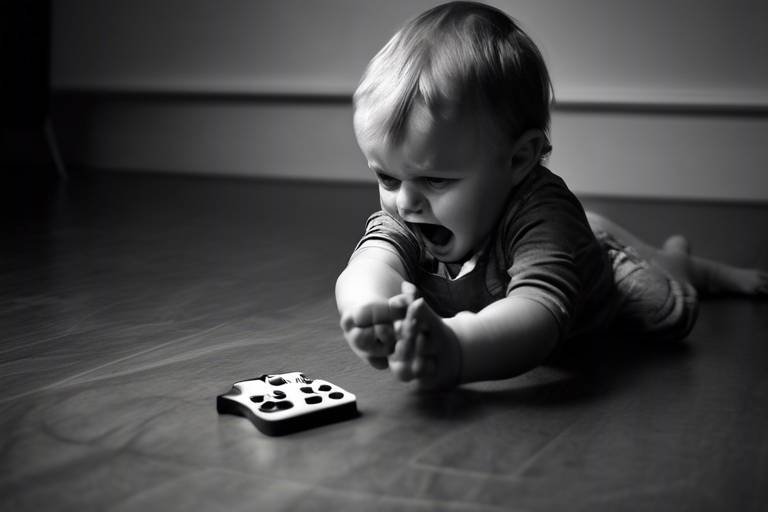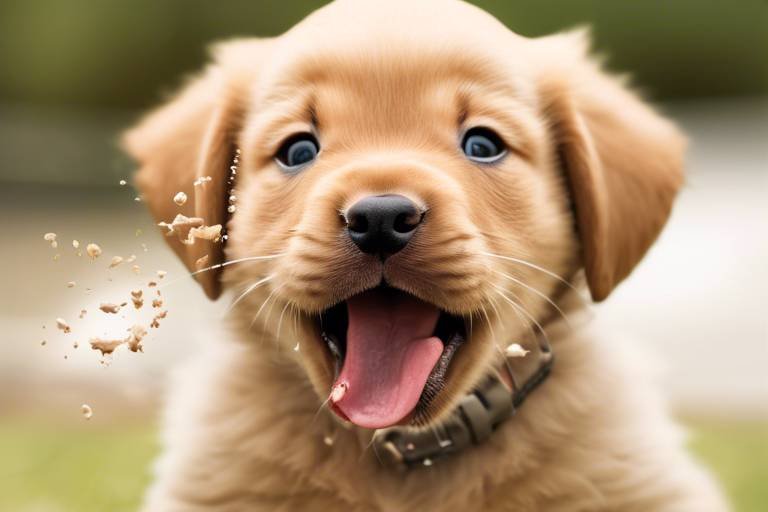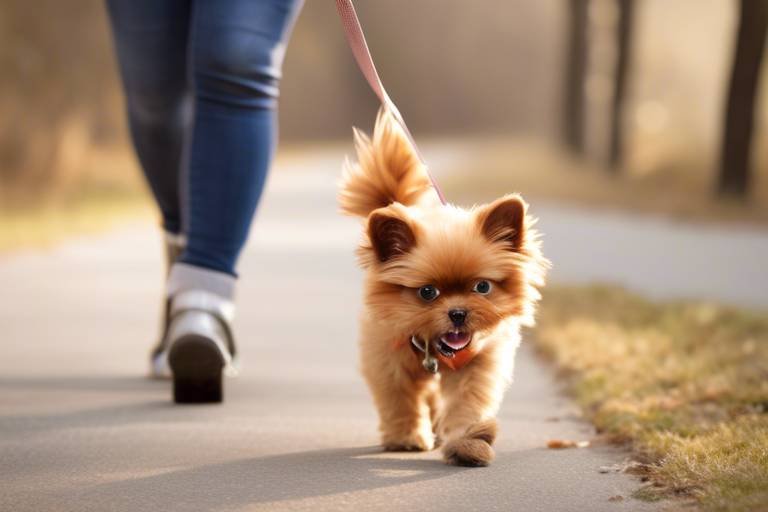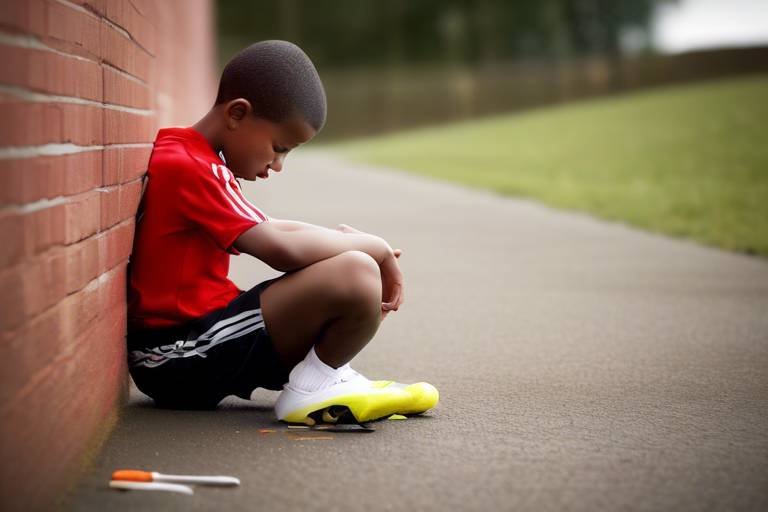Tips for Teaching Your Dog to Recognize Commands with Visual Cues
Training your dog can be one of the most rewarding experiences, but it can also be a bit challenging. If you've ever found yourself wondering why your furry friend isn't responding to your commands, it might be time to rethink your approach. One effective strategy is to use visual cues alongside verbal commands. This article will provide you with effective strategies for using visual cues to enhance your dog’s understanding of commands, making training more engaging and successful for both you and your furry friend.
Visual cues are essential in dog training as they can enhance communication between you and your pet. Think of it this way: just like humans often rely on body language to understand each other, dogs can also pick up on visual signals. These cues can include hand signals, facial expressions, and even your overall body posture. By incorporating visual cues into your training sessions, you can create a more dynamic learning environment for your dog. This approach not only helps to clarify commands but also makes the training process more enjoyable for both of you.
Selecting appropriate visual cues is crucial for effective training. The key here is to choose cues that are clear, consistent, and easily recognizable by your dog. For instance, if you decide to use a hand signal for "sit," make sure it is distinct and different from other gestures you use. This will ensure that your dog doesn’t get confused. Remember, dogs are visual learners, so the clearer the cue, the better they will understand what you want them to do.
There are several common visual cues used in dog training. These cues can be incredibly effective in conveying commands to your dog. Some popular examples include:
- Hand Signals: Simple gestures that can be easily recognized by your dog.
- Body Movements: Shifts in your posture that indicate a command.
- Facial Expressions: Using your face to communicate excitement or disapproval.
Using these visual cues can significantly enhance your dog's ability to understand commands, making training sessions more productive.
Hand signals are among the most effective visual cues in dog training. They can be simple gestures, like raising your hand to signal "stay," or more complex movements for different commands. The important thing is to use specific gestures consistently. For example, if you use a flat palm facing down for "down," always use that same gesture. This consistency helps your dog associate the gesture with the command, making it easier for them to respond correctly.
Your body language plays a significant role in training. Dogs are incredibly perceptive and can pick up on subtle changes in your posture and movements. For instance, leaning slightly forward can signal to your dog that you want them to come closer, while turning your body away might indicate that they should stop. Being aware of your own body language can reinforce the visual cues you're using, helping your dog to better understand your commands.
Consistency is key in dog training. Using the same visual cues consistently is vital to avoid confusion and enhance your dog’s learning experience. Imagine trying to learn a new language but getting different signals every time – it would be frustrating, right? The same goes for your dog. If you switch up your cues or use different gestures for the same command, your dog may become confused and less likely to respond. Stick to your chosen cues and use them consistently to create a solid foundation for your dog's training.
Integrating visual cues into verbal commands can significantly improve your dog’s response. For example, when you say "sit," simultaneously use your hand signal. This dual approach reinforces the command and helps your dog make the connection between your voice and your gestures. It’s like giving them two channels of communication, which can be incredibly effective.
Regular practice sessions are vital for reinforcing visual cues. Aim for short, focused training sessions that keep your dog engaged. Dogs have short attention spans, so five to ten minutes is often enough. During these sessions, focus on one command at a time, using both verbal and visual cues. This structured approach ensures your dog learns and retains the commands effectively. Remember to keep it fun and rewarding!
Incorporating rewards during training can motivate your dog to learn. Positive reinforcement is a powerful tool in dog training. When your dog responds correctly to a visual cue, reward them with treats, praise, or playtime. This not only reinforces the behavior but also makes your dog more eager to participate in future training sessions. The more positive experiences your dog has during training, the more they will want to learn.
Q: How long does it take for my dog to learn visual cues?
A: The time it takes can vary greatly depending on the dog’s age, breed, and previous training experiences. Generally, with consistent practice, most dogs can learn new cues within a few weeks.
Q: Can I use visual cues with older dogs?
A: Absolutely! Dogs of all ages can learn visual cues. Older dogs may take a little longer to adjust, but with patience and consistency, they can be trained effectively.
Q: What if my dog doesn’t respond to visual cues?
A: If your dog isn’t responding, it may be due to confusion or inconsistency in cues. Review your training methods and ensure you’re using clear, consistent signals. It might also help to decrease distractions during training sessions.

Understanding Visual Cues
When it comes to training your furry friend, visual cues are like the secret sauce that can make a world of difference! Imagine trying to communicate with someone who speaks a different language; that’s what it can feel like for our dogs when we only use verbal commands. Visual cues bridge that gap, enhancing the connection between you and your pet. They are essentially signals that your dog can see, such as hand movements or body posture, which help them understand what you want them to do.
Dogs are incredibly perceptive creatures, and they often pick up on visual signals faster than they do on verbal commands. This is because their natural instincts are geared towards reading body language and visual expressions. For instance, when you point to a spot, your dog may instinctively follow your finger, associating that action with the command “go there.” This natural inclination makes visual cues a powerful tool in your training arsenal.
To effectively utilize visual cues, it’s essential to ensure that they are clear and consistent. Just like how we might struggle to follow a conversation if the speaker keeps changing their tone or volume, dogs can become confused if the visual signals are inconsistent. For example, if you use a different hand gesture each time you want your dog to sit, it could lead to frustration and misunderstanding. Therefore, establishing a set of clear visual cues that you always use will help your dog learn faster and respond more reliably.
Another fascinating aspect of visual cues is that they can be combined with verbal commands to create a richer learning experience for your dog. Think of it like a movie with both stunning visuals and an engaging soundtrack; together, they create a captivating experience. When you pair a verbal command, like “sit,” with a hand signal, your dog is more likely to understand and respond. This dual approach not only reinforces the command but also makes training sessions more engaging for both of you.
In summary, understanding and implementing visual cues in your training routine can lead to a more effective and enjoyable experience for both you and your dog. By focusing on clear, consistent signals and integrating them with verbal commands, you'll create a communication style that resonates with your furry friend. So, are you ready to dive into the exciting world of visual cues and transform your training sessions?

Choosing the Right Cues
When it comes to teaching your dog through visual cues, is absolutely paramount. Think of visual cues as the bridge that connects your commands to your dog's understanding. Just like how we use gestures to express ourselves, your furry friend relies on clear signals to grasp what you want from them. So, how do you go about selecting these cues? It’s simpler than you might think! First and foremost, you want to ensure that your cues are clear and consistent.
Consider this: if you were learning a new language, would you prefer your teacher to use a jumble of words or clear, distinct phrases? The same goes for your dog. If you use vague or overly complicated gestures, your pup may end up more confused than enlightened. Aim for cues that are easily recognizable. For instance, a simple raised hand for 'sit' or a sweeping motion for 'come' can work wonders. The key here is to keep it straightforward and intuitive.
Another important aspect is to think about the context in which you'll be using these cues. Are you training in a noisy park or a quiet living room? The environment can greatly influence how well your dog picks up on visual cues. In a bustling atmosphere, you might need to amplify your gestures to ensure they catch your dog's attention. In contrast, a calm setting allows for more subtle movements.
To help you visualize this better, here’s a quick table summarizing some effective cues and their contexts:
| Visual Cue | Recommended Context |
|---|---|
| Raised Hand | Indoors or quiet environments |
| Pointing | Outdoors, when directing attention |
| Clapping | To gain attention in noisy settings |
Moreover, you should consider the size and movement of your cues. Larger, more exaggerated gestures are generally more effective, especially for dogs that may not be as attentive to subtle movements. Imagine trying to see a tiny flag waving in a strong wind; it’s much easier to spot a big, bright banner! So, don’t be shy—make those gestures big and bold!
Lastly, it’s essential to be mindful of your dog's individual personality. Some dogs are naturally more perceptive, while others may need a bit more time to understand. Pay attention to how your dog responds to different cues and be prepared to adjust as necessary. Your training sessions should feel like a fun game rather than a chore, so keep the energy positive and encouraging.
In summary, when choosing the right visual cues for your dog, focus on clarity, consistency, and context. Make your gestures large and engaging, and always consider your dog's unique learning style. With the right cues in place, you’ll be well on your way to a successful training journey, filled with understanding and joy!
Common Visual Cues
When it comes to dog training, visual cues play a pivotal role in bridging the communication gap between you and your furry companion. These cues are not just random gestures; they are carefully chosen signals that help your dog understand what you want from them. Think of visual cues as the silent language of training, allowing your dog to respond without relying solely on auditory commands. By using clear and consistent visual signals, you can make training sessions more engaging and effective.
There are several popular visual cues that trainers and dog owners often use. These cues can be as simple as a hand signal or a specific body movement. Here are some of the most common visual cues that you might find helpful:
- Hand Signals: These are specific gestures made with your hands that communicate commands. For example, raising your hand palm-out can signal your dog to "stay," while a sweeping motion can indicate "come." The key is to ensure that these signals are distinct and easy for your dog to recognize.
- Body Movements: Your overall body language can also serve as a visual cue. Leaning forward may suggest excitement or encouragement, while turning your body away can indicate a need for your dog to stop what they’re doing. Your dog is observant and will pick up on these subtle cues.
- Facial Expressions: Believe it or not, your facial expressions can convey a lot. A smile can encourage your dog, while a stern look might communicate disapproval. Dogs are incredibly perceptive and can read your emotions through your face.
Using these visual cues effectively requires practice and consistency. For instance, if you decide to use a hand signal for "sit," make sure you use the same gesture every time you want your dog to sit. Inconsistency can lead to confusion, and your dog may not understand what you’re asking. Additionally, pairing visual cues with verbal commands can enhance your dog's learning experience. For example, saying "sit" while simultaneously using the hand signal reinforces the command and makes it easier for your dog to grasp.
In summary, incorporating common visual cues into your training routine can significantly improve your dog's understanding and response to commands. Remember, the more engaging and consistent you are with these cues, the more successful your training will be. So, get ready to unleash your creativity and have fun while teaching your dog!
Q: How long does it take for a dog to learn visual cues?
A: The time it takes for a dog to learn visual cues varies based on the individual dog and the consistency of training. Generally, with regular practice, most dogs can learn basic cues within a few weeks.
Q: Can I use visual cues with older dogs?
A: Absolutely! Dogs of all ages can learn to recognize visual cues. It may take a little longer for older dogs, but with patience and persistence, they can definitely learn.
Q: What if my dog doesn’t respond to visual cues?
A: If your dog isn’t responding, ensure that you are using clear and consistent signals. Additionally, it may help to combine visual cues with verbal commands and rewards to reinforce learning.
Hand Signals
Hand signals are an incredibly effective tool in dog training, serving as a bridge between verbal commands and your dog's understanding. Imagine trying to communicate with someone who speaks a different language; using hand gestures can often convey your message more clearly. Similarly, your dog may respond better to visual signals than to verbal commands alone. This is especially true for dogs that are more visually oriented or those that may have hearing impairments. When you use hand signals, you're not just giving commands; you're enhancing your dog's ability to interpret your intentions.
To get started with hand signals, it’s essential to choose gestures that are clear and distinct. For instance, a simple raised hand can mean "sit," while a sweeping motion might indicate "come." The key is to ensure that each signal is unique and easy for your dog to recognize. You can create a mini-table of your chosen hand signals to keep track of what each one means:
| Command | Hand Signal |
|---|---|
| Sit | Raised hand, palm facing up |
| Come | Waving hand towards you |
| Stay | Hand held out, palm facing forward |
Once you have established your signals, practice them consistently. Consistency is key! Use the same gestures every time you give a command, as this will help your dog associate the signal with the action you want them to take. Start in a quiet environment with minimal distractions, and gradually increase the level of difficulty by introducing more distractions or practicing in different locations.
Another tip is to pair your hand signals with verbal commands initially. For example, say “sit” while raising your hand. This dual approach reinforces the command and helps your dog make the connection between the two. Over time, you can start to phase out the verbal commands as your dog becomes more adept at responding to the signals alone.
Additionally, remember that your energy and enthusiasm can greatly affect your dog's response. If you approach training with excitement, your dog will likely mirror that energy. Celebrate small victories, and don't forget to reward your dog with treats or praise when they respond correctly. This positive reinforcement will encourage them to keep learning and engaging with you during training sessions.
In conclusion, hand signals can be a game-changer in your dog training journey. They not only enhance communication but also create a stronger bond between you and your furry companion. So, roll up your sleeves, get those hands moving, and watch your dog thrive!
- Can I use hand signals with older dogs?
Absolutely! Dogs of all ages can learn to respond to hand signals. Just be patient and consistent. - How long does it take for my dog to learn hand signals?
Every dog is different, but with regular practice, many dogs can learn new signals within a few weeks. - What if my dog doesn’t respond to hand signals?
Try simplifying your signals or ensuring you’re in a distraction-free environment. Consistency and positive reinforcement are key!
Body Language
Your body language is one of the most powerful tools you have in dog training. Just think about it: when you meet someone, their posture, gestures, and overall demeanor can tell you a lot about how they're feeling, right? The same concept applies to your furry friend. Dogs are incredibly perceptive creatures, and they pick up on your non-verbal cues more than you might realize. If you're slouching or looking away while giving a command, your dog may feel uncertain, leading to confusion and frustration for both of you.
To effectively use body language in training, it’s essential to maintain a confident and open posture. Stand tall, face your dog directly, and use clear, deliberate movements. This not only helps your dog understand that you mean business but also builds a stronger bond of trust and respect between you. For instance, when giving a command like "sit," you can raise your hand with an open palm while simultaneously bending your knees slightly to encourage your dog to follow your lead. This combination of a visual cue and your body posture reinforces the command and makes it easier for your dog to understand what you want.
Moreover, consistency in your body language is crucial. If you use a specific gesture or posture for a command, make sure to use it every single time. Imagine if you told your friend to "come here" by waving your hand one day and then just pointing the next; they’d likely be confused about what you want. Dogs are no different! By maintaining the same body language for each command, you reduce the chances of miscommunication and enhance your dog’s learning experience.
Another aspect to consider is the emotional tone conveyed through your body language. Are you anxious, excited, or frustrated? Dogs are experts at reading these signals. If you’re tense or upset, your dog may become anxious or hesitant. Conversely, if you’re relaxed and happy, your dog is more likely to respond positively to your commands. It’s essential to be aware of how your emotions can influence your body language and, in turn, your dog’s behavior.
Finally, remember that training should be a fun and engaging experience for both you and your dog. Incorporate playful movements and positive energy into your sessions. For example, when your dog successfully follows a command, celebrate with a happy dance or a cheerful clap. This not only reinforces the behavior but also creates a joyful atmosphere that your dog will look forward to. After all, who wouldn’t want to train with a happy human?
In summary, being mindful of your body language can significantly enhance your dog’s understanding of commands. By maintaining a confident posture, using consistent gestures, and conveying positive emotions, you set the stage for successful training sessions that deepen your bond with your furry companion.
- How important is body language in dog training?
Body language is crucial as dogs are highly attuned to non-verbal cues. Consistent and clear body language can significantly improve your dog's understanding of commands. - Can my dog understand my emotions through body language?
Yes! Dogs are incredibly perceptive and can pick up on your emotional state through your posture and movements, which can affect their behavior. - What are some common body language mistakes to avoid?
Avoid slouching, inconsistent gestures, and showing frustration. These can confuse your dog and hinder the training process. - How can I make training more engaging for my dog?
Incorporate playful movements, celebrate successes, and maintain a positive atmosphere to make training enjoyable for both you and your dog.
Consistency in Training
When it comes to dog training, consistency is your secret weapon. Imagine trying to learn a new language, but every time you practice, the rules change. Frustrating, right? That’s exactly how your dog feels when you don’t use consistent visual cues. Dogs thrive on routine and repetition, and if you want your furry friend to grasp commands effectively, you need to be as steady as a metronome.
Using the same visual cues every time you give a command is essential. For instance, if you decide to use a hand signal for "sit," make sure you always use that same gesture. If one day you raise your hand high and the next you just point down, your dog is left scratching its head in confusion. This inconsistency can lead to misunderstandings, where your dog might simply ignore your command or, worse, respond incorrectly. So, how can you ensure consistency in your training sessions?
Start by establishing a set of visual cues that you will stick with throughout your training journey. Write them down if you have to! Here’s a simple table to help you visualize your cues:
| Command | Visual Cue |
|---|---|
| Sit | Hand raised palm up |
| Stay | Open palm facing the dog |
| Come | Waving hand towards you |
This table is a great reference point that can keep you on track. It’s also helpful to practice these cues in front of a mirror or with a friend, so you can see how clear your signals are. Remember, your dog is watching you closely. If your body language and visual cues don’t match your verbal commands, it can lead to a breakdown in communication.
Moreover, consistency isn’t just about the cues you use; it’s also about the environment in which you train. Try to use the same space for practice sessions, and minimize distractions as much as possible. If your dog learns to associate certain cues with specific locations or scenarios, it will help reinforce their understanding. For example, if you always practice "sit" in the living room, your dog will start to associate that space with the command.
Lastly, don’t forget that your mood and energy levels play a significant role in training consistency. Dogs are incredibly perceptive and can pick up on your emotions. If you’re feeling frustrated or distracted, your dog might not respond as well. So, take a deep breath, stay positive, and make training a fun and engaging experience for both of you. After all, a happy trainer leads to a happy dog!
- How long should training sessions be? Aim for short, focused sessions of about 5-10 minutes, especially for younger dogs. This keeps their attention and makes learning enjoyable.
- Can I use different visual cues for the same command? While it's possible, it's best to stick to one visual cue per command to avoid confusion.
- What if my dog doesn't respond to the visual cues? Be patient! It may take time for your dog to understand. Consistently reinforce the cues and consider rewarding them for their efforts.
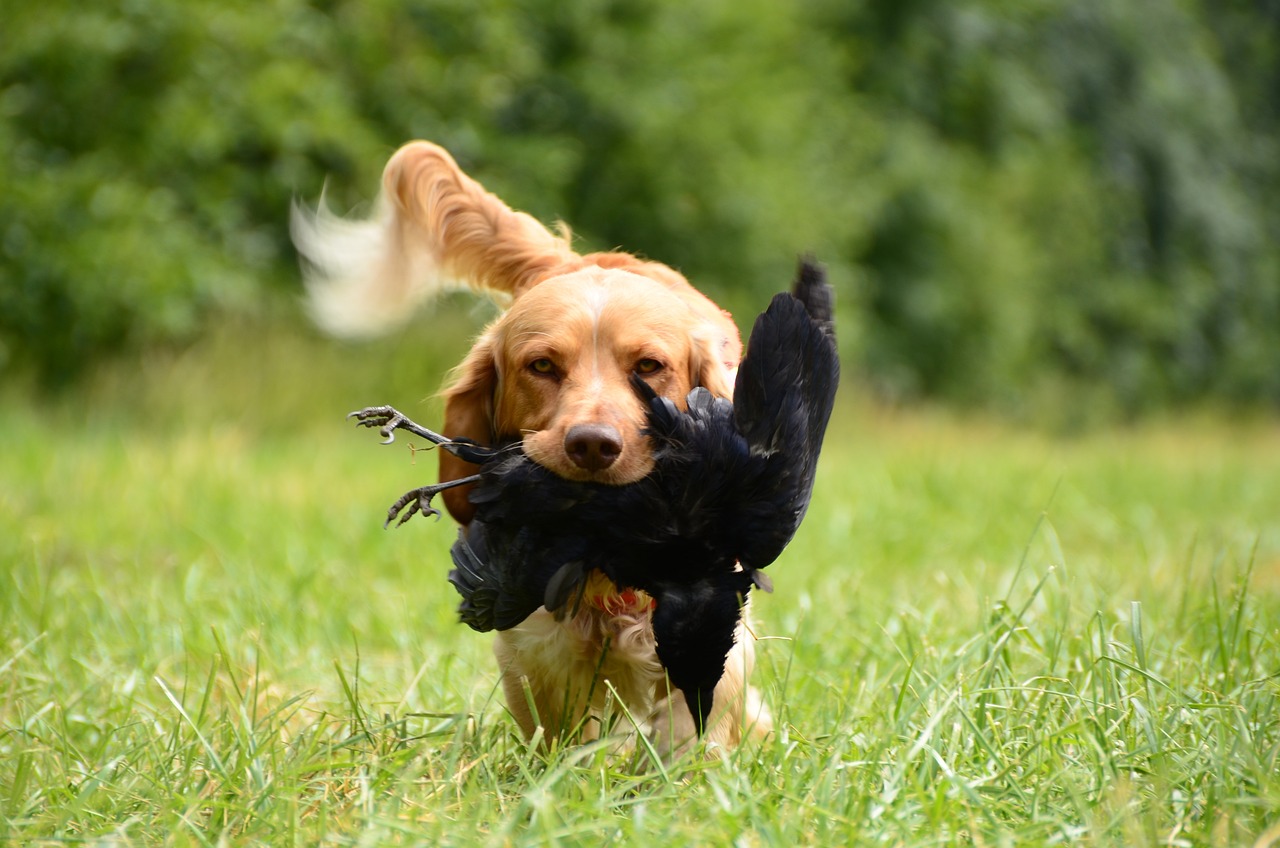
Incorporating Visual Cues into Commands
Integrating visual cues into verbal commands can significantly enhance your dog's learning experience. Imagine trying to have a conversation in a noisy room; often, non-verbal signals can help convey your message more clearly. Just like that, your furry friend can benefit immensely from a combination of visual and auditory signals. By pairing visual cues with your verbal commands, you create a multi-sensory learning environment that can make training more effective and enjoyable.
When it comes to incorporating visual cues, consistency is crucial. Always use the same hand signals or body movements associated with each command. For instance, if you're teaching your dog to sit, you might use an upward hand gesture along with the word "sit." Over time, your dog will begin to associate the visual cue with the action, making it easier for them to respond correctly. Remember, the goal is to create a clear connection between what you say and what you show.
To effectively combine visual and verbal cues, consider the following strategies:
- Start Simple: Begin with one command at a time. Trying to teach multiple commands simultaneously can overwhelm your dog and lead to confusion.
- Use Clear Signals: Ensure your hand signals are distinct and easy to understand. Avoid using complex gestures that could confuse your dog.
- Practice Regularly: Consistent practice is essential. Incorporate visual cues into your daily training routine to reinforce learning.
Additionally, you can use visual cues to redirect your dog's attention. For example, if your dog is distracted, a quick hand signal can bring them back to focus. This technique not only aids in command recognition but also helps in maintaining a positive training atmosphere. Remember, dogs are highly visual learners, and they often respond better when they can see what is expected of them.
Moreover, don't forget to celebrate your dog's successes! When they respond correctly to a command, whether it's through a verbal cue, visual cue, or both, shower them with praise and rewards. This positive reinforcement strengthens their understanding and encourages them to continue learning. Think of it as a fun game where both you and your dog are engaged. The more you practice and reward, the more your dog will want to participate.
In conclusion, incorporating visual cues into your dog's training can lead to remarkable improvements in their ability to understand and follow commands. By creating a clear and engaging training environment, you not only enhance your dog's learning but also deepen the bond between you and your furry companion. So, grab those treats, get your hands ready for some signals, and watch your dog thrive!
Practice Sessions
When it comes to teaching your dog to recognize commands through visual cues, regular practice sessions are absolutely essential. Think of these sessions as the building blocks of your dog's understanding. Just like humans need repetition to learn new skills, dogs thrive on consistent practice to grasp what you are trying to communicate. The key is to make these sessions engaging and fun, turning the training into a game rather than a chore.
So, how do you structure these practice sessions? Start by setting aside a specific time each day dedicated to training. This consistency helps your dog understand that it’s time to focus and learn. Aim for short but effective sessions, ideally between 5 to 15 minutes. Dogs have limited attention spans, and keeping the sessions brief means they won’t get bored or frustrated. Here’s a simple outline for a practice session:
| Time (Minutes) | Activity | Objective |
|---|---|---|
| 5 | Warm-up with familiar commands | Reinforce existing skills |
| 5 | Introduce a new visual cue | Expand learning |
| 5 | Practice with rewards | Encourage positive reinforcement |
During these practice sessions, it’s crucial to remain patient and upbeat. If your dog doesn’t seem to grasp a cue right away, don’t lose heart! Instead, try to adjust your approach. Sometimes, a slight change in your body language or the way you present the cue can make a world of difference. Remember, dogs are incredibly intuitive creatures, and they often pick up on our emotions. If you’re excited and positive, your furry friend is likely to mirror that energy.
Another important aspect of practice sessions is the use of rewards. Dogs are motivated by treats, praise, and playtime. When your dog successfully responds to a visual cue, shower them with affection and rewards. This not only reinforces the behavior but also creates a positive association with the command. You might consider using a variety of rewards to keep things interesting. For instance, you could alternate between treats, verbal praise, and a quick game of fetch. This variety ensures that your dog remains engaged and eager to learn.
Lastly, don’t forget to end each session on a positive note. Whether your dog has mastered a new cue or is still learning, always conclude with a fun activity or a favorite treat. This leaves your dog looking forward to the next training session, creating a cycle of excitement and learning. Remember, training your dog is a journey, and with consistent practice sessions, you'll both enjoy the ride!
- How often should I practice with my dog? Aim for daily sessions, but even a few times a week can be beneficial.
- What if my dog isn't responding to visual cues? Be patient and try adjusting your cues or the environment. Sometimes distractions can hinder learning.
- Can I train my dog without treats? Yes! You can use praise, toys, or playtime as rewards, but treats can be very effective for motivation.
Using Rewards
When it comes to training your dog, motivation is everything. Just like humans, dogs respond positively to rewards, and using them effectively can make all the difference in your training sessions. Imagine you're at a concert, and the band plays your favorite song; you can't help but feel excited and engaged. That’s the kind of enthusiasm you want to evoke in your dog during training! By incorporating rewards, you can create a fun and positive learning environment that encourages your furry friend to pick up commands with ease.
So, what types of rewards should you consider? Here are some popular options:
- Treats: These are often the most effective rewards. Choose small, tasty treats that your dog loves. Just remember to keep them bite-sized to avoid overfeeding!
- Praise: Verbal praise is a powerful tool. Use an enthusiastic tone to let your dog know they're doing well. Simple phrases like "Good boy!" or "Well done!" can boost their confidence.
- Playtime: For some dogs, a game of fetch or tug-of-war can be the ultimate reward. If your dog loves to play, use it as a way to reinforce their learning.
Now, let’s talk about timing. Timing is crucial when rewarding your dog. You want to give the reward immediately after your dog successfully performs the command. This helps them make the connection between the action and the reward. Think of it like a light bulb moment for your dog; they need to understand that their action led to something good happening. If you wait too long, they might not associate the reward with the command, which can lead to confusion.
Another important aspect is to vary the rewards. While treats may be your go-to, mixing in praise and playtime can keep your dog engaged and excited about training. Just like how you might get tired of eating the same meal every day, dogs can also lose interest if the rewards become predictable. Keep things fresh and exciting!
Lastly, as your dog becomes more proficient with commands, you can start to phase out the treats. This doesn’t mean you stop rewarding them altogether; rather, you can gradually reduce the frequency of treats while still offering praise and playtime. This method, known as intermittent reinforcement, can help maintain your dog's motivation and keep them eager to learn.
In conclusion, using rewards in dog training is not just about giving treats; it's about creating a positive experience that encourages your dog to learn and grow. By understanding what motivates your dog, timing your rewards appropriately, and varying them, you can make your training sessions enjoyable and effective. Remember, a happy dog is a well-trained dog!
Q: How often should I reward my dog during training?
A: Initially, reward your dog every time they successfully follow a command. As they become more proficient, you can start to phase out treats and use praise or playtime instead.
Q: What if my dog doesn’t seem motivated by treats?
A: Every dog is different! If your dog isn’t motivated by treats, try using toys, praise, or playtime as rewards. Experiment to find what excites your dog the most.
Q: Can I use the same reward for different commands?
A: Absolutely! Consistency in rewards can help reinforce learning. Just ensure that your dog understands the connection between the command and the reward.
Q: How can I tell if my dog is enjoying the training?
A: Look for signs of enthusiasm, such as wagging tails, perked ears, and an eagerness to participate. If your dog seems disinterested, it may be time to reassess your training methods or rewards.
Frequently Asked Questions
- What are visual cues in dog training?
Visual cues are signals that you use to communicate commands to your dog without relying solely on verbal instructions. They can include hand gestures, body movements, or even facial expressions that help your dog understand what you want them to do.
- How do I choose the right visual cues for my dog?
Choosing the right visual cues involves selecting signals that are clear, consistent, and easily recognizable by your dog. Make sure to use gestures that are distinct and not easily confused with other movements to avoid any misunderstanding during training sessions.
- Can you give examples of common visual cues?
Absolutely! Some common visual cues include:
- Hand signals, like raising your hand for "sit."
- Pointing to a spot for "go there."
- Waving your hand to indicate "come."
- How important is consistency in using visual cues?
Consistency is crucial in dog training. Using the same visual cues every time helps your dog learn and understand what you expect from them. Inconsistent cues can lead to confusion, making the training process less effective.
- How can I effectively incorporate visual cues with verbal commands?
To effectively combine visual cues with verbal commands, start by saying the command while demonstrating the visual cue simultaneously. This method reinforces the command and helps your dog make the connection between the two, enhancing their learning experience.
- What should I do during practice sessions?
During practice sessions, keep them short and engaging. Focus on one or two commands at a time, and gradually introduce new visual cues as your dog becomes more comfortable. Regular practice will help reinforce their understanding and retention of the commands.
- How can rewards be used in training with visual cues?
Rewards are a fantastic way to motivate your dog! Use treats, praise, or playtime as rewards when your dog successfully responds to a visual cue. This positive reinforcement encourages them to continue learning and responding to your commands.



